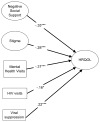Psychosocial and Service Use Correlates of Health-Related Quality of Life Among a Vulnerable Population Living with HIV/AIDS
- PMID: 27787675
- PMCID: PMC5774014
- DOI: 10.1007/s10461-016-1589-1
Psychosocial and Service Use Correlates of Health-Related Quality of Life Among a Vulnerable Population Living with HIV/AIDS
Abstract
Among people living with HIV/AIDS (PLHIV), health-related quality of life (HRQOL) is an important clinical metric of perceived well-being. Baseline data from the BEACON study (N = 383) were used to examine relationships between HRQOL and negative social support, HIV-related stigma, viral suppression, and physical and mental health service use among a vulnerable population of low-income, urban PLHIV who currently or formerly used substances, and were primarily African American. Factor analyses and structural equation modeling indicated that increases in negative social support, stigma, mental health care visits and HIV physician visits were associated with lower HRQOL, while viral suppression was associated with greater HRQOL. The association between negative social support and HRQOL suggests the importance of intervening at the dyad or network levels to shape the type of social support being provided to PLHIV. HIV-related stigma is another negative social factor that is prevalent in this sample and could be addressed by intervention. Results indicate that greater mental and physical health service use can be used to identify individuals with lower HRQOL. Therefore, findings increase an understanding of HRQOL in this understudied population and have implications for designing interventions to improve HRQOL among PLHIV.
Keywords: African American or Black; Drug use disorder; HIV-related stigma; HIV/AIDS; Health-related quality of life; Negative social support.
Figures

Similar articles
-
Stigmas, symptom severity and perceived social support predict quality of life for PLHIV in urban Indian context.Health Qual Life Outcomes. 2016 Nov 3;14(1):152. doi: 10.1186/s12955-016-0556-x. Health Qual Life Outcomes. 2016. PMID: 27809839 Free PMC article.
-
Perceived social support, coping, and stigma on the quality of life of people living with HIV in Nepal: a moderated mediation analysis.AIDS Care. 2019 Apr;31(4):413-420. doi: 10.1080/09540121.2018.1497136. Epub 2018 Jul 11. AIDS Care. 2019. PMID: 29996657
-
Psychosocial correlates of health-related quality of life among people living with HIV in China: the mediating role of resilience.AIDS. 2019 Jun 1;33 Suppl 1:S63-S70. doi: 10.1097/QAD.0000000000002180. AIDS. 2019. PMID: 31397724
-
Meta-analysis of health and demographic correlates of stigma towards people living with HIV.AIDS Care. 2009 Jun;21(6):742-53. doi: 10.1080/09540120802511877. AIDS Care. 2009. PMID: 19806490 Review.
-
Problems undermining the health-related quality of life of people living with HIV in Spain: a qualitative study to inform the development of a novel clinic screening tool.Health Qual Life Outcomes. 2022 May 25;20(1):84. doi: 10.1186/s12955-022-01978-y. Health Qual Life Outcomes. 2022. PMID: 35614470 Free PMC article. Review.
Cited by
-
The Stepped Care Intervention to Suppress Viral Load in Youth Living With HIV: Protocol for a Randomized Controlled Trial.JMIR Res Protoc. 2019 Feb 27;8(2):e10791. doi: 10.2196/10791. JMIR Res Protoc. 2019. PMID: 30810536 Free PMC article.
-
Mental health and retention in HIV care: A systematic review and meta-analysis.Health Psychol. 2018 Jun;37(6):574-585. doi: 10.1037/hea0000606. Health Psychol. 2018. PMID: 29781655 Free PMC article.
-
Does Posttraumatic Growth Buffer the Association Between Death Anxiety and Quality of Life Among People living with HIV/AIDS?J Clin Psychol Med Settings. 2021 Jun;28(2):229-238. doi: 10.1007/s10880-020-09708-6. J Clin Psychol Med Settings. 2021. PMID: 32086637
-
Quality of Life and Associated Factors of HIV Patients Under Treatment with First Line Regimens in Public Hospitals in Amhara Region, North-West Ethiopia.Patient Prefer Adherence. 2023 Jun 2;17:1347-1359. doi: 10.2147/PPA.S413192. eCollection 2023. Patient Prefer Adherence. 2023. PMID: 37287512 Free PMC article.
-
Health-related quality of life assessment among people living with HIV in Rio de Janeiro, Brazil: a cross-sectional study.Qual Life Res. 2019 Apr;28(4):1035-1045. doi: 10.1007/s11136-018-2044-8. Epub 2018 Nov 10. Qual Life Res. 2019. PMID: 30415417
References
-
- Perez IR, Bano JR, Ruz ML, et al. Health-related quality of life of patients with HIV: impact of sociodemographic, clinical and psychosocial factors. Quality of Life Research. 2005;14(5):1301–1310. - PubMed
-
- Wu A, Lamping D. Assessment of quality of life in HIV disease. AIDS-LONDON-CURRENT SCIENCE THEN RAPID SCIENCE PUBLISHERS THEN LIPPINCOTT RAVEN- 1994;8:S349–S349.
-
- Buseh AG, Kelber ST, Stevens PE, Park CG. Relationship of Symptoms, Perceived Health, and Stigma With Quality of Life Among Urban HIV-Infected African American Men. Public Health Nursing. 2008;25(5):409–419. - PubMed
-
- Ware JE, Jr, Kosinski M, Bayliss MS, McHorney CA, Rogers WH, Raczek A. Comparison of methods for the scoring and statistical analysis of SF-36 health profile and summary measures: summary of results from the Medical Outcomes Study. Med Care. 1995:AS264–AS279. - PubMed
-
- Ware JE, Jr, Kosinski M, Keller SD. A 12-Item Short-Form Health Survey: construction of scales and preliminary tests of reliability and validity. Med Care. 1996;34(3):220–233. - PubMed
MeSH terms
Grants and funding
LinkOut - more resources
Full Text Sources
Other Literature Sources
Medical

